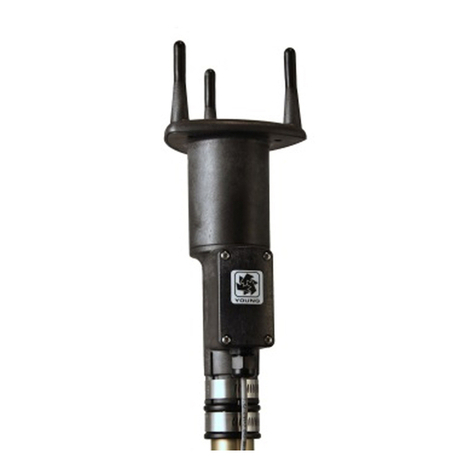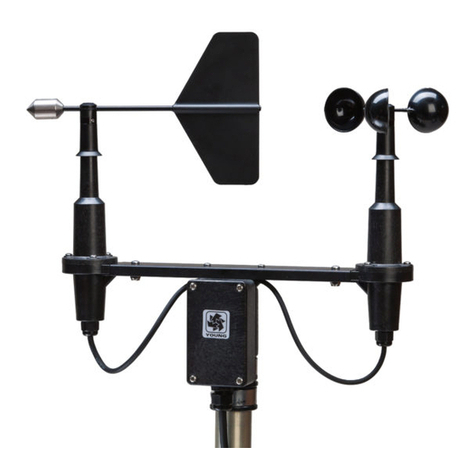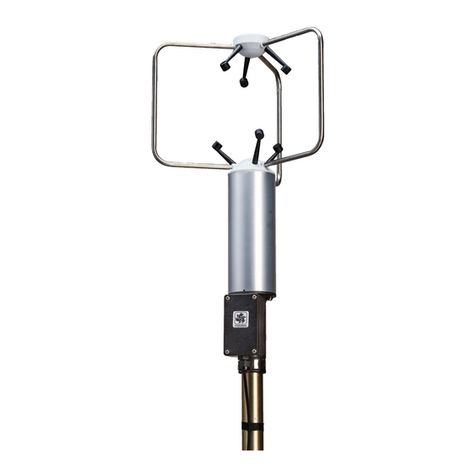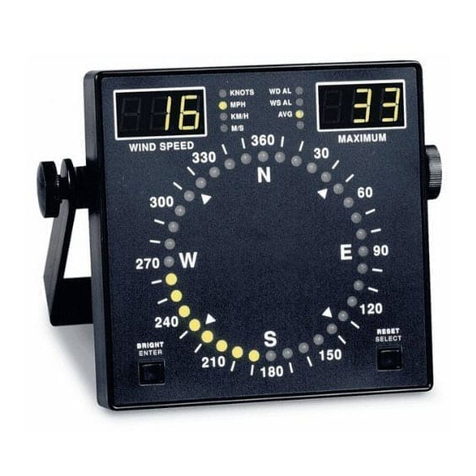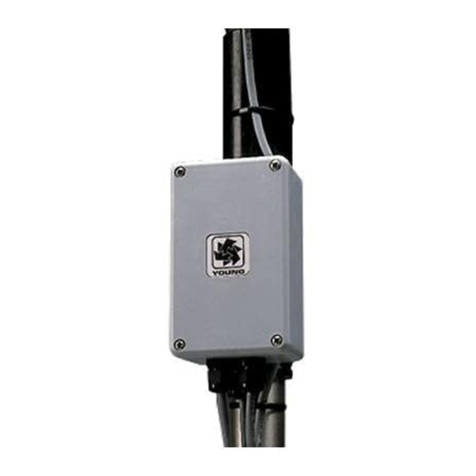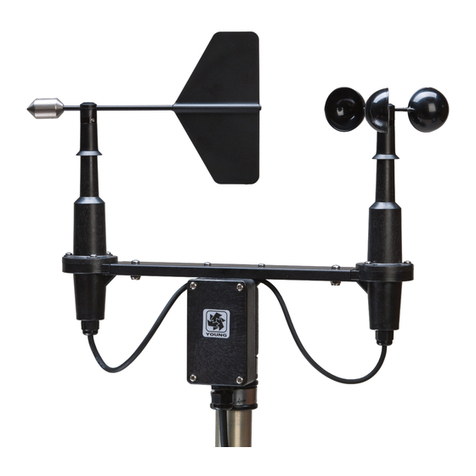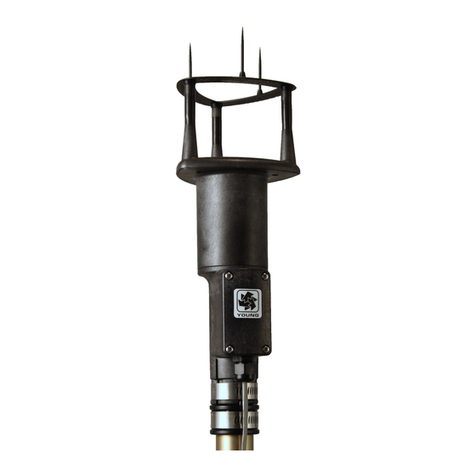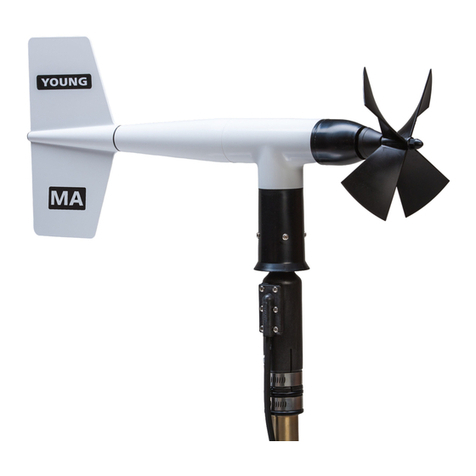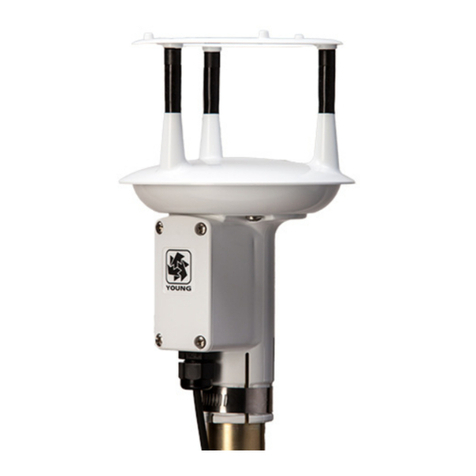
Page 2
03102L-90 (A)
CALIBRATION
The Wind Sentry is fully calibrated before shipment and should
require no adjustments. Recalibration may be necessary after some
maintenance operations. Periodic calibration checks are desirable
and may be necessary where the instrument is used in programs
which require auditing of sensor performance.
Wind speed calibration is determined by the cup wheel turning factor
and the output characteristics of the transducer. The calibration
formula relating cup wheel rpm to wind speed is shown below.
Standard accuracy is ±0.5 m/s (1.1 mph). For greater accuracy, the
sensor must be individually calibrated in comparison with a wind
speed standard. Contact the factory or your supplier to schedule a
NIST (National Institute of Standards & Technology) traceable wind
tunnel calibration in our facility.
To calibrate wind system electronics, temporarily remove the cup
wheel and connect a Model 18802 Anemometer Drive to the cup
wheel shaft. Apply the calibration formula to the motor rpm and adjust
the signal conditioning electronics for proper value. For example,
with the cup wheel shaft turning at 1800 rpm, adjust the indicator
to display 22.7 meters per second. (0.01250 X 1800 + 0.2 = 22.7))
CALIBRATION FORMULAS
Model 03102L Wind Sentry Anemometer
WIND SPEED vs CUP WHEEL RPM
m/s = (0.01250 x rpm) + 0.2
knots = (0.02427 x rpm) + 0.4
mph = (0.02795 x rpm) + 0.4
km/h = (0.04499 x rpm) + 0.7
WIND SPEED vs mA OUTPUT
m/s = ((mA - 4.06) x 3.125) + 0.2
knots = ((mA - 4.05) x 6.0745) + 0.4
mph = ((mA - 4.05) x 6.9904) + 0.4
km/h = ((mA - 4.06) x 11.2500) + 0.7
MAINTENANCE
Given proper care, the Wind Sentry should provide years of
service. Because of its durable, corrosion resistant construction,
the instrument requires little maintenance. The only components
likely to require replacement due to normal wear are the precision
ball bearings. Replacement of these components should only be
performed by a qualied instrument technician. If service facilities
are not available, return the instrument to the factory. Refer to the
accompanying drawings to become familiar with part names and
locations. Maximum torque on all set screws is 80 oz-in.
ANEMOMETER FLANGE BEARING REPLACEMENT
If anemometer bearings become noisy or wind speed threshold
increases above an acceptable level, replace the bearings. Check
bearing condition by hanging an ordinary paper clip (0.5 gm) on the
outside edge of one cup while the instrument is held in a horizontal
position. The cup should rotate downward. Failure to rotate due to
the weight of the paper clip indicates anemometer bearings need
replacement. Repeat this test at different positions to check full
bearing rotation. Replace bearings as follows:
1. REMOVE BEARINGS
a) Loosen set screw on side of cup wheel hub. Remove cup
wheel.
b) Remove three screws which hold two sections of main
housing.
c) Carefully separate upper and lower housing. Remove coil
transducer assembly from upper housing. Do not disconnect
from circuit board.
d) Loosen screw and remove ring magnet on end of shaft
inside upper housing.
e) Slide shaft and skirt assembly out of both upper and lower
bearings.
f) Using knife blade under bearing ange, carefully remove
upper bearing.
g) Using a pencil, gently push out lower bearing from above.
2. INSTALL NEW BEARINGS
a) Insert new upper bearing. Use care not to apply excessive
pressure.
b) Slide cup wheel shaft through upper bearing.
c) Slide lower bearing on shaft inside upper housing.
d) Using ring magnet assembly, push lower bearing into
its seat in upper housing.
e) Secure ring magnet to shaft using screw removed in step
1d. Use a small amount of sealant on screw to prevent it
from loosening.
f) Join two housing sections. Secure using three screws
removed in step 1b.
g) Place cup wheel on shaft. Tighten set screw on side of hub.
Do not exceed 80 oz-in torque.

